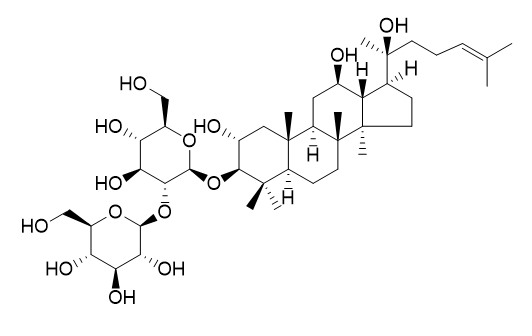Gypenoside L
Gypenoside L inhibits autophagic flux and induces cell death in human esophageal cancer cells through endoplasm reticulum stress-mediated Ca2+ release. It also possesses non-small cell lung carcinoma A549 cell inhibitory activity.
Inquire / Order:
manager@chemfaces.com
Technical Inquiries:
service@chemfaces.com
Tel:
+86-27-84237783
Fax:
+86-27-84254680
Address:
1 Building, No. 83, CheCheng Rd., Wuhan Economic and Technological Development Zone, Wuhan, Hubei 430056, PRC
Providing storage is as stated on the product vial and the vial is kept tightly sealed, the product can be stored for up to
24 months(2-8C).
Wherever possible, you should prepare and use solutions on the same day. However, if you need to make up stock solutions in advance, we recommend that you store the solution as aliquots in tightly sealed vials at -20C. Generally, these will be useable for up to two weeks. Before use, and prior to opening the vial we recommend that you allow your product to equilibrate to room temperature for at least 1 hour.
Need more advice on solubility, usage and handling? Please email to: service@chemfaces.com
The packaging of the product may have turned upside down during transportation, resulting in the natural compounds adhering to the neck or cap of the vial. take the vial out of its packaging and gently shake to let the compounds fall to the bottom of the vial. for liquid products, centrifuge at 200-500 RPM to gather the liquid at the bottom of the vial. try to avoid loss or contamination during handling.
Polytechnic University of Catalonia2017, 105826
iScience.2024, 27(8):110496.
CZECH MYCOLOGY2021, 73(1):1-19.
Int J Mol Sci.2024, 25(5):2799.
Molecules.2023, 28(8):3376.
Kyung Hee University2024, 4789969.
Toxicol In Vitro.2024, 99:105876.
J. Food Composition and Anal.2022, V 109:104482.
Molecules.2021, 26(6):1635.
Front Pharmacol.2020, 11:683.
Related and Featured Products
Archives of Pharmacal Research, 2013, 36(7):874-879.
Dammarane-type saponins from heat-processed Gynostemma pentaphyllum show fortified activity against A549 cells.[Reference:
WebLink]
METHODS AND RESULTS:
An ethanol extract from heat-processed Gynostemma pentaphyllum showed more potent cytotoxic activity against human lung adenocarcinoma A549 cells than that of raw G. pentaphyllum. Four constituents were isolated from heat-processed G. pentaphyllum using resin HP-20, silica gel and reversed ODS column chromatography. They were identified by mass and NMR spectra as damulin A and damulin B, Gypenoside L and Gypenoside LI, respectively. To evaluate the efficacy of these four constituents, the MTT cytotoxicity assay was performed using A549 cells.
CONCLUSIONS:
Based on the structure of these four constituents, the results indicate that the hydroxyl group in C-2 and double bond in C20(21) and C20(22) positions are of importance in inhibition of A549 cell proliferation.
Oncotarget, 2016, 7(30):47387-47402.
Gypenoside L inhibits autophagic flux and induces cell death in human esophageal cancer cells through endoplasm reticulum stress-mediated Ca2+ release.[Reference:
WebLink]
Esophageal cancer is one of the leading cause of cancer mortality in the world. Due to the increased drug and radiation tolerance, it is urgent to develop novel anticancer agent that triggers nonapoptotic cell death to compensate for apoptosis resistance.
METHODS AND RESULTS:
In this study, we show that treatment with Gypenoside L (Gyp-L), a saponin isolated from Gynostemma pentaphyllum, induced nonapoptotic, lysosome-associated cell death in human esophageal cancer cells. Gyp-L-induced cell death was associated with lysosomal swelling and autophagic flux inhibition. Mechanistic investigations revealed that through increasing the levels of intracellular reactive oxygen species (ROS), Gyp-L triggered protein ubiquitination and endoplasm reticulum (ER) stress response, leading to Ca2+ release from ER inositol trisphosphate receptor (IP3R)-operated stores and finally cell death. Interestingly, there existed a reciprocal positive-regulatory loop between Ca2+ release and ER stress in response to Gyp-L. In addition, protein synthesis was critical for Gyp-L-mediated ER stress and cell death.
CONCLUSIONS:
Taken together, this work suggested a novel therapeutic option by Gyp-L through the induction of an unconventional ROS-ER-Ca2+-mediated cell death in human esophageal cancer.
Journal of the Agricultural Chemical Society of Japan, 2014, 78(2):311-316
Determination by UPLC-MS of four dammarane-type saponins from heat-processed Gynostemma pentaphyllum.[Reference:
WebLink]
Heat-processed Gynostemma pentaphyllum and its main dammaran-type saponins, Gypenoside L, Gypenoside LI, damulin B, and damulin A, possess non-small cell lung carcinoma A549 cell inhibitory activity.
METHODS AND RESULTS:
We established in this study a method by ultra-high performance liquid chromatography with tandem mass spectrometry for determination of the saponins and also investigated their content change in heat-processed G. pentaphyllum.
CONCLUSIONS:
The main saponins increased with increasing heating temperature and time. Further investigation showed that they were produced from gypenoside XLVI and Gypenoside LVI by undergoing hydrolysis during the heat treatment.



